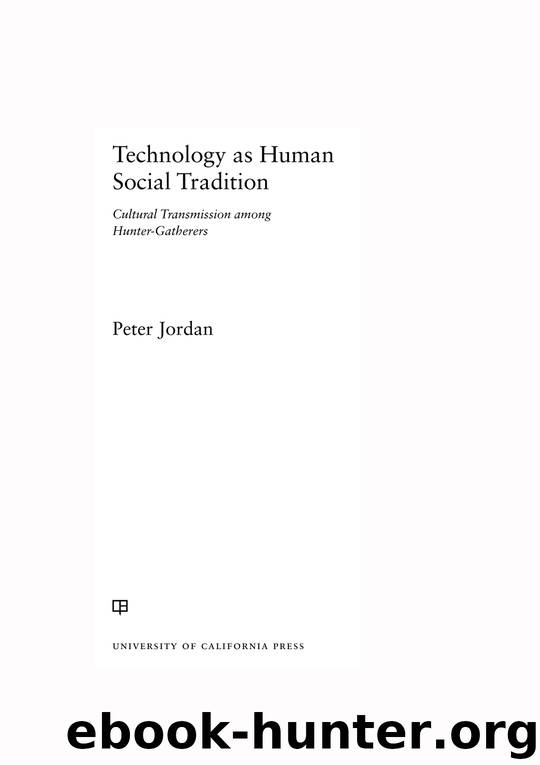Technology as Human Social Tradition by Jordan Peter;

Author:Jordan, Peter;
Language: eng
Format: epub
Publisher: University of California Press
NOTES
Note 1. Seventeenth- to Nineteenth-Century Demography and Marriage Patterns: Iugan River Khanty and Neighboring Populations
Demography
The earliest Russian records of iasak fur-taxpayers (not the overall population) living on the Iugan, Iuganskaia Ob’, and Balyk Rivers was 116 in 1629, rising to 125 in 1645, followed by 133 in 1680 and 148 in 1706. This might indicate a steady growth in local households or reflect the increasing reach of the tax system into remoter areas (Martynova 1998:140). Later sources record the entire population and indicate that the Iuganskaia Ob’ population hovered around 350 from 1782 to 1897, but that populations on the Malyi Iugan went through a major decline, from 352 down to 141, and populations along the Bolshoi Iugan showing a steady rise, from 493 in 1792, to 554 in 1897 (Martynova 1998:140–41). The current Iugan Khanty population numbers just under a thousand (Bakhlykov 1996:6). For demographic information pertaining to other Eastern Khanty rivers, see Martynova (1998).
Regional Marriage Contacts
There were particularly intensive marriage contacts within the Iugan basin and also regular marriages with communities on other rivers (Martynova 1998:140–42). For example, on the Malyi Iugan (figure 3.1), 19 percent of all mid-nineteenth-century marriages were conducted within that basin, and 28 percent involved partners from the Bolshoi Iugan; 40 percent were from the Iuganskaia Ob’ and Balyk, and the rest of partners were drawn from elsewhere, for example, 6 percent with the Trom”egan Khanty. On the Bolshoi Iugan, 30 percent of marriages were internal to that basin, 23 percent were with the Malyi Iugan Khanty, 25 percent were with partners from the Iuganskaia Ob’ and Balyk Rivers, and the rest involved more distant communities. In general, nearly all marriages across the region involved other Khanty communities, with interethnic marriages (e.g., with Sel’kup or Nenets), amounting to only 0.6 percent of all Eastern Khanty marriages recorded during the seventeenth to nineteenth centuries. Similarly, interactions with Russians were also limited and very infrequent –at the end of the nineteenth century, there were 5,964 Eastern Khanty in the Middle Ob’ region but only 140 Russians, living mainly in Surgut and local administrative villages (Lukina 1985:16). Currently, most Iugan Khanty appear to marry within their own community, occasionally with more distant Khanty communities, and also with other occasional incomers to the main village of Ugut (see Wiget and Balalaeva 2011).
Download
This site does not store any files on its server. We only index and link to content provided by other sites. Please contact the content providers to delete copyright contents if any and email us, we'll remove relevant links or contents immediately.
Sapiens: A Brief History of Humankind by Yuval Noah Harari(13941)
Sapiens by Yuval Noah Harari(5100)
Homo Deus: A Brief History of Tomorrow by Yuval Noah Harari(4662)
Pale Blue Dot by Carl Sagan(4589)
Livewired by David Eagleman(3520)
Origin Story: A Big History of Everything by David Christian(3457)
Brief Answers to the Big Questions by Stephen Hawking(3226)
Inferior by Angela Saini(3135)
Origin Story by David Christian(2973)
The Gene: An Intimate History by Siddhartha Mukherjee(2905)
Signature in the Cell: DNA and the Evidence for Intelligent Design by Stephen C. Meyer(2861)
The Evolution of Beauty by Richard O. Prum(2855)
Aliens by Jim Al-Khalili(2686)
How The Mind Works by Steven Pinker(2600)
A Short History of Nearly Everything by Bryson Bill(2493)
Sex at Dawn: The Prehistoric Origins of Modern Sexuality by Ryan Christopher(2399)
From Bacteria to Bach and Back by Daniel C. Dennett(2381)
Endless Forms Most Beautiful by Sean B. Carroll(2339)
Who We Are and How We Got Here by David Reich(2328)
